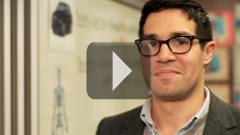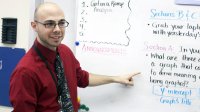How the School of the Future Got It Right
This New York City, 6-12 school measures student ability through formative assessments, presentations, exhibitions, and tests. Their special sauce? A rigorous focus on measuring “authentic” tasks tied to real world challenges.
Your content has been saved!
Go to My Saved Content.The School of the Future (SOF) is a grades 6-12 public school in New York City's bustling Gramercy Park neighborhood. Rising 11 stories above the East Side of Manhattan, SOF is a small school -- it has fewer than 700 students -- and is well known as a progressive one, a place where students develop the ability to think critically rather than just ace a standardized test.
What makes this school different is this: SOF measures the full range of student ability through formative assessments, presentations, exhibitions, and tests that focus on authentic tasks to assess students' skills and knowledge as they relate to real-world endeavors. SOF holds its students (and its teachers) to high standards of performance, demanding a level of rigor not found in many other schools. Notes Stacy Goldstein, the director and principal of SOF's middle school, "We are serious about figuring out how to fold assessment and accountability into our progressive school culture." And here's proof that what they are doing works: Although 40 percent of SOF students qualify for free or reduced-price lunch, 98 percent of them graduate and continue their education by going on to college.
Like all schools, SOF faces its own peculiar challenges. The building is nearly 100 years old and shows it. With classrooms housed on 10 floors, it's not easy to foster a full-blown sense of community. There is also room for a wider and deeper infusion of technology into the learning process. Nevertheless, SOF is succeeding impressively. When we visited, we discovered a smart, enthusiastic, and ultra-dedicated community of administrators, students, teachers, and parents. We also discovered their unflagging approach to comprehensive assessment, which they call authentic assessment.
Authentic Assessment
There are many ways to talk about authentic assessment, but the essence of this approach is that it is, in fact, authentic. This means that a physics assessment should involve doing physics -- performing experiments and solving problems the same way that a real-life physicist would. An authentic history assessment requires students to ask questions, do independent research, and formulate answers to their questions, just like a real-life historian does.
What else does authentic assessment do?
- It engages students and is based in content or media in which the students actually have a genuine interest.
- It asks students to synthesize information and use critical-thinking skills.
- It is a learning experience in and of itself.
- It measures not just what students remember but how they think.
- It helps students understand where they are academically and helps teachers know how to best teach them.
SOF's Rob Olazagasti teaches sixth-grade science. To teach a unit on the human cell -- the smallest unit of life -- and then assess what the students had learned, he used a "go big" strategy as in "big city" big.

He had his students research organelles, the discrete structures within a cell that have specialized functions. Then he had the class build a model of New York City, one that matched the functions of major city departments to the functions of each organelle in a cell (e.g., the nucleus was the mayor's office, the endoplasmic reticulum was the subway system, and so on). Next, the class constructed large models of actual organelles inside one gigantic cell in Rob's classroom. (Words can barely do it justice. Watch the video for yourself.) Finally, the students taught an in-depth lesson to their fellow students while standing inside the gigantic cell.
Authentic assessment does not always have to involve building humongous human cells and models of New York City. But the thinking and planning that Rob used can be replicated in just about any classroom in any school. And that leads us to . . .
Planning
Authentic assessment involves a substantial amount of planning, specifically backward planning. That means you start at the end. It goes like this:
- Identify the goals, skills, and knowledge that you want your students to ultimately acquire.
- Determine what that learning would actually look and sound like (the teachers at SOF use a lot of rubrics).
- Devise summative assessments (projects, presentations, etc.) that will demonstrate your students' learning at the end of a unit.
- Devise formative assessments (small check-ins) that will lead your students to the summative assessment and help you know how to teach them along the way.
- Create lessons and projects to promote the learning you want to happen.
If this sounds like a lot of advance work, it is. Authentic assessment is front-loaded for teachers, but according to SOF learning specialist Whitney Lukens, "It makes teaching more efficient and really speeds things up." Because you always know where your students are in the learning process, you can be much more directed in your teaching, and you avoid wasting time teaching students what they already know or aren't yet ready to learn. It also means you're a lot less likely to reach the end of a unit only to discover what your students didn't learn. (Talk to others who care about assessment in Edutopia's Assessment Group.)
Still, planning takes time and that brings us to . . .
School Culture
No teacher is an island at the School of the Future. Put simply, there's no way that an individual teacher could pull off authentic assessment without substantial support for her efforts. SOF teachers benefit from a great deal of professional-development time, both in-house and in collaboration with Columbia University's Teachers College. And SOF middle school director, Stacy Goldstein, and high school director, John Fanning, make sure their teachers have the time they need to teach and to assess. Some of the structures built into the SOF schedule include the following:
- Weekly grade-level team meetings for teachers
- Two to five common planning times per week for same-subject teachers and special education teachers
- Half-day Thursdays when all SOF teachers can plan and meet
As part of the New York Performance Standards Consortium and in keeping with the principles of the Coalition of Essential Schools, SOF students work on year-long research and writing projects, called exhibitions, in lieu of the New York Regents Exams, which are typically required of high school students in the state of New York. You can learn more about SOF's exhibitions here.
This much planning time may not be possible at every school. But if school leaders can find ways to give teachers more planning time, they are likely to see positive results, especially around assessment. SoF high school director John Fanning says, "The most concrete example is that when our kids come back from their first year of college, they thank us and say, 'I can write a 20-page research paper and my roommate can't.' Also, they feel more comfortable talking. They report they are participating in class discussions and backing up what they say with evidence and that they feel very comfortable in their first year of college."
We invite you to learn more about the School of the Future, to watch its teachers in action, and to see how they use authentic assessment to answer the key question that every educator must address: How do we know the students got it?
School Of The Future
Enrollment
689 | Public, UrbanPer Pupil Expenditures
$5000 per general ed student per the Fair Student Funding formula.Free / Reduced Lunch
40%DEMOGRAPHICS:
2% English-language learners
17% Individualized education programs
